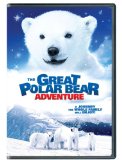The Great Polar Bear Adventure is indoctrination pure and simple. Disguised as a warm and fuzzy nature show in the realm of Meerkat Manor and its like, this film has really only one theme.: Humans are very bad creatures, for the most part. It follows the plight of a family of polar bears who can no longer find the frozen ice river floes that provide them with tasty seal meat. The reason, of course, is what the bears call the two legs. Somehow the bears know that it is the two legs that are causing the winter to grow shorter and the ice flows to disappear earlier every year. Of course, for the last two years ice floes have returned to normal, but let’s not confuse the issue with the facts. Eventually the bears are driven closer to a two leg settlement where they are forced to rummage through trash piles in order to survive. Eventually one of the rare good two legs darts them and takes them further north where they can roam and survive…for now.
Whatever your politics, I would hope that the idea of using children’s entertainment to push an agenda would not be why you might buy a video for the kids. There are plenty of good programs out there, so that it doesn’t seem necessary to have to have a conversation with your kids to explain why humans are so evil. Not the message I would want to send to children. Sure, the bears are cute and the CG animators did a great job of making it look like they were actually speaking. I don’t even mind a moral or a good message at the end of a kid’s show, but I assure you that you will find this program heavy handed.
Video
The program is presented in a surprising 2.35:1 aspect ratio. I assume it was originally a television broadcast, but I had not seen or heard of it previously. Most of the footage is put together from various nature documentary pieces and so has a quite varied look in quality. Most of it is a bit fuzzy with plenty of grain. There were a few newer shots made at a zoo using real bears and green screen f/x, but they look very obvious, although clearer in quality.
Audio
The Dolby Digital 2.0 track is here for dialog and nothing more. It does its job well.
Special Features
Making Of The Great Polar Bear Adventure: This 10 minute piece focuses on the task of the CG lip animation and the putting together of footage from many sources.
Final Thoughts:
I generally like nature shows. The talking or story created versions are a relatively new genre, and some are quite good. I find that generally when taken as a whole series it tends to get tedious, so I rather gravitate to these one off films. Unfortunately I don’t wish to be preached at. Who really enjoys being scolded for entertainment. If I want that, I’ll go to a Rodney Dangerfield performance. I don’t need polar bears scolding me. My advice on this film? “Forget it.”






04/22/2012 @ 7:11 am
Heres some info on polar bearsThe polar bear (Ursus maritimus) is a bear vtniae to the Arctic Ocean and its surrounding seas. The world’s largest carnivore found on land, a title it shares with the Kodiak Bear,[3] an adult male weighs around 400–680 kg (880–1,500 lb),[4] while an adult female is about half that size. Although it is closely related to the brown bear, it has evolved to occupy a narrow ecological niche, with many body characteristics adapted for cold temperatures, for moving across snow, ice, and open water, and for hunting the seals which make up most of its diet.[5] Although most polar bears are born on land, it spends most of its time at sea, hence its name meaning maritime bear , and can hunt consistently only from sea ice, spending much of the year on the frozen sea.The polar bear is classified as a vulnerable species, with 5 of the 19 polar bear subpopulations in decline.[6][7] For decades, unrestricted hunting raised international concern for the future of the species; populations have rebounded after controls and quotas began to take effect. For thousands of years, the polar bear has been a key figure in the material, spiritual, and cultural life of Arctic indigenous peoples, and the hunting of polar bears remains important in their cultures.The IUCN now lists global warming as the most significant threat to the polar bear, primarily because the melting of its sea ice habitat reduces its ability to find sufficient food. The IUCN states, If climatic trends continue polar bears may become extirpated from most of their range within 100 years. [1] On May 14, 2008, the United States Department of the Interior listed the polar bear as a threatened species under the Endangered Species Act.Naming and etymologyConstantine John Phipps was the first to describe the polar bear as a distinct species.[1] He chose the scientific name Ursus maritimus, the Latin for maritime bear’,[8] due to the animal’s vtniae habitat. The Inuit refer to the animal as nanook,[9] (transliterated as nanuuq in the Inupiat language[10], and nanuuk in Siberian Yupik.[citation needed]) The bear is umka in the Chukchi language. In Russian, it is usually called ????? ??????? (Bely Medved, the White Bear), though an older word still in use is ????? (Oshkuy, which comes from the Komi Oski, bear ).[11] In Quebec French, the polar bear is referred to as Ours polaire.[12] The polar bear was previously considered to be in its own genus, Thalarctos.[13] However, evidence of hybrids between polar bears and brown bears, and of the relatively recent evolutionary divergence of the two species, does not support the establishment of this separate genus, and the accepted scientific name is now therefore Ursus maritimus, as Phipps originally proposed.[14]Taxonomy and evolutionPolar bears depend on sea ice as a platform for hunting seals. Large feet and short, stocky claws are adaptations to this environment.The bear family, Ursidae, is believed to have split off from other carnivorans about 38 million years ago. The Ursinae subfamily originated approximately 4.2 million years ago. According to both fossil and DNA evidence, the polar bear diverged from the brown bear, Ursus arctos, roughly 200,000 years ago. The oldest known polar bear fossil is less than 100,000 years old. Fossils show that between ten to twenty thousand years ago, the polar bear’s molar teeth changed significantly from those of the brown bear. Polar bears are thought to have diverged from a population of brown bears that became isolated during a period of glaciation in the Pleistocene.[15]More recent genetic studies have shown that some clades of brown bear are more closely related to polar bears than to other brown bears,[16] meaning that the polar bear is not a true species according to some species concepts.[17] In addition, polar bears can breed with brown bears to produce fertile grizzly–polar bear hybrids,[15][18] indicating that they have only recently diverged and are genetically similar.[19] However, as neither species can survive long in the other’s ecological niche, and with distinctly different morphology, metabolism, social and feeding behaviors, and other phenotypic characteristics, the two bears are generally classified as separate species.[19]When the polar bear was originally documented, two subspecies were identified: Ursus maritimus maritimus by Constantine J. Phipps in 1774, and Ursus maritimus marinus by Peter Simon Pallas in 1776.[20] This distinction has since been invalidated.One fossil subspecies has been identified. Ursus maritimus tyrannus—descended from Ursus arctos—became extinct during the Pleistocene. U.m. tyrannus was significantly larger than the living subspecies.hope i helped:)